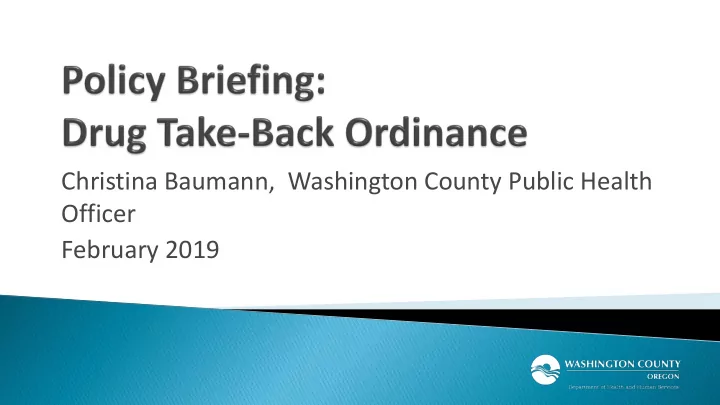

Christina Baumann, Washington County Public Health Officer February 2019
Unused prescription drugs can lead to abuse and accidental poisonings. Flushing pharmaceuticals can contaminate our waterways and negatively affect our aquatic ecosystems. Limited places for drug disposal in Washington County.
Source : National Vital Statistics System, 2008; Automated Reports Consolidated Orders System, 2010.
Over 1.5 million opioid prescriptions were filled in the Portland metro area. That’s enough for nearly every person to get one. 413,000 opioid prescriptions were filled in Washington County, with an average of 3.3 prescriptions per patient.
Overdose Deaths: ◦ In 2017, 193 people died from an opioid overdose (tri-county region). Ambulance Calls: ◦ Average of 2.7 overdoses a week from 9/2017- 9/2018 (Washington County). ED/Urgent Care OD-Related Visits: ◦ 302 visits in 2017 (Washington County) ◦ Increased visits in 2017 and 2018 Four out of five heroin users were hooked on prescription opioids before ever using heroin.
The EPR model makes the manufacturer responsible for the lifecycle of the product. ◦ Similar to unused paint. Estimated cost to pharmaceutical companies: ◦ One cent for every ten dollars of prescription (0.1% of sales). Put before Supreme Court in 2015 but Court refused to hear.
EPR ordinances ◦ Alameda County’s EPR model (2012) was the first drug take - back ordinance. ◦ Adopted by at least five counties in Washington, 12 in California, and one in Illinois. Increased medication collection ◦ San Francisco’s pharmacies collected 80,437 pounds of medications, compared to law enforcement collecting 4,095 pounds prior to the EPR ordinance in the same time span.
Establish an ordinance based on Alameda County’s EPR model that supports Oregon statewide drug take-back HB 2645A. Pharmaceutical producers will design, manage, collect and fund take-back programs. Pharmaceutical producers will provide a minimum number of collection sites to residents. Washington County Public Health will provide oversight.
Pharmacy and law enforcement involvement is voluntary. Pharmaceutical producers are required to offer education and outreach. The County would recommend pharmacies host drop boxes as a public service and collaborate with the Oregon Board of Pharmacy.
“As a water resources management utility focused on the protection of public health and the environment, our industry strongly supports drug take- back programs.” — Mark Jockers Government and Public Affairs Manager Clean Water Services
What questions does PHAC have about this potential local ordinance? What community partners are important to support this work? Upcoming BOC meetings March 19 & April 2 PHAC letter of support
Recommend
More recommend